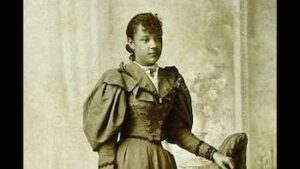
Anna M. Mangin
*Anna M. Mangin's birth is celebrated on this date in 1844. She was a Black inventor, educator, and caterer.
She was born Anna Matilda Barker in Louisiana. On her 1877 marriage application, she listed her parents as Jacob Barker and P. [Polly?] Shelton. Jacob Barker was a white-American planter, merchant, and politician. Barker, a native of Maine, worked using Louisiana state laws to free over one hundred Northern-born Africans who had been enslaved. Annie arrived in Nantucket, Massachusetts, through the Underground Railroad conductor Charles Bennett Ray. She was taken in by Ray's sister and her husband, a shoemaker and a native of Surinam. Annie was adopted by the childless couple and was known as Annie Mattie Nahar.
During the American Civil War, Annie Nahar was a student at the Nantucket High School. Heeding the for teachers to go South, in June 1864, she left for New Orleans, where she taught school for four years under the Freedmen's Bureau before moving to San Antonio, Texas. In 1870, Nahar returned to New Orleans as principal of the Coliseum School. By 1877, she was the "principal of one of the McDonogh Schools that had been established from a bequest by a wealthy slave owner who left his estate for the support of free schools for children regardless of color" when she met Andrew Fitch Mangin, a thirty-four-year-old Black man from Monroe, New York who was employed at various times as a coachman and a teamster. In August 1877, they married in New Orleans and moved to New York City, where she was a cook and a caterer while Andrew went into business with his brothers.
On January 7, 1879, Annie Mangin gave birth to their only surviving child, a son. Soon after the family's return to the North, Andrew Mangin bought a building lot in the county of Queens, built a small house, and moved his family there. He continued transacting the freight business with his brothers until 1895 when he opened a coal yard on that lot. Annie Mangin and her catering business also taught some colored children in Woodside. Anna M. Mangin invented a kitchen tool she called a pastry fork in 1891. This was different from the eating utensil, also known as a pastry fork; she received the patent for the pastry fork on March 1, 1892. Mangin's pastry fork was displayed at the New York Afro-American Exhibit at the World's Columbian Exposition in 1893.
Mangin participated in a charity fair held on behalf of the Women's Loyal Union that supported the Protective Union House for Working Girls. She helped operate the Star Booth with librarian Florence T. Ray and was staffed by H. Cordelia Ray, Susan Elizabeth Frazier, and Carrie Fortune. After her husbands died in 1907, Andrew Mangin, Jr. purchased a chicken farm in Brookfield, Connecticut, and mother and son moved there. Anna Mangin died in a hospital in Danbury, Connecticut, on March 1, 1931, and was buried in the Mangin family plot in Evergreens Cemetery.